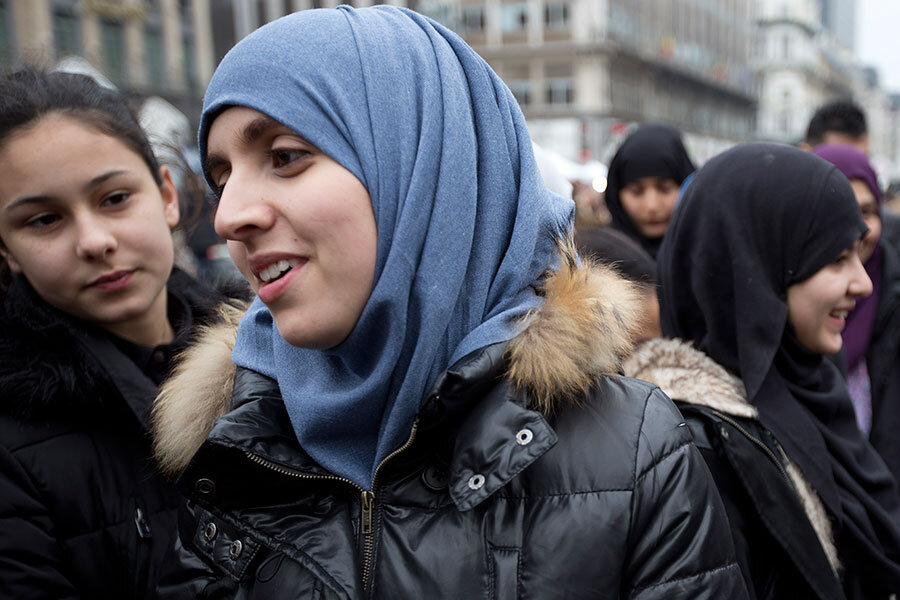How US and Europe differ on fighting terror, integrating Muslims
Loading...
Two bombings in Brussels Tuesday brought terrorism back into the spotlight following last year’s Islamist extremist attacks in Paris and San Bernardino, Calif. But it also highlighted the differences between the United States and Europe, both in demographics and responses to terrorism.
1. How do the US and European Muslim populations differ?
In 2015, the American Muslim population was roughly 3.3 million, or about 1 percent of the total population. That share is predicted to double to 2 percent by 2020.
By comparison, Europe’s Muslim population was 44.1 million in 2010 and is expected to climb to 58 million by 2030, according to the Pew Research Center.
Furthermore, Muslims make up a far greater share of the population in European cities than in American cities. Some cities in Western Europe have Muslim populations of more than 20 percent. According to research by The Daily Beast, Washington has the highest percentage of Muslim residents of any major American city with about 2 percent.
America and Europe also differ significantly in the nature of their Muslim populations. The Muslim-American population is ethnically diverse, hailing from 77 different countries, with many coming to study and work and entering the middle and professional classes.
By contrast, many of Europe’s Muslim communities grew from an influx of immigrants after World War II due to a labor shortage on the Continent. European nations signed labor deals with former colonies. For example, Algerians generally went to France, Moroccans to Spain, and Pakistanis to Britain.
2. How have Europe and the US differed in integrating their Muslim populations?
European governments have broadly failed to come up with ways to integrate most communities, despite some having gone to extraordinary lengths in trying.
“You have large populations in major cities that are unemployed, can’t get access to education or jobs training, and are left disenfranchised and are largely feeling marginalized and discriminated against,” says Julianne Smith, a senior fellow and director of the Strategy and Statecraft Program at the Center for a New American Security.
These conditions are no guarantee of radicalization, but they do increase susceptibility, she adds.
America’s Muslim integration story tends to be different: “In the United States, because we’re a country of immigrants ... it is less complicated to come to become part of the ... American culture because there’s no one thing that defines it.”
However, the poll numbers on European and American attitudes toward Muslims flip the integration story.
The British, Germans, and French have an overwhelmingly “favorable” view of Muslims, ranging from 69 to 76 percent, according to a Pew poll from late last year.
Americans, on the other hand, are more on the fence, with 53 percent expressing favorable views, according to a 2015 Brookings poll.
3. How are the security challenges faced by the US and Europe different?
“I think pretty much since 9/11 we’ve come to learn that the United States and Europe tackle those issues in different ways,” Ms. Smith says.
The US has been more focused using its military to target terrorist cells at their roots – think the wars in Afghanistan and Iraq.
Following the London and Spain bombings, Europe has focused more on law enforcement and intelligence and also counter-radicalization, believing philosophically that military campaigns only “fan the flames of extremism,” Smith says.
Europe’s shared land border with the Middle East is a challenge not faced by the US. For those European Muslims who do radicalize, it’s much easier for them to reach Islamic State strongholds in Iraq and Syria. European security officials are currently trying to keep tabs on an estimated 7,000 fighters who have trained or fought with the Islamic State, while the US currently has about 200 who have gone or tried to go, according to NBC News.
4. How much do the US and Europe cooperate?
“We’ve made a number of really important strides since 9/11. We’re much better in terms of sharing passenger data, we have extradition agreements, we have enhanced intel sharing, we’ve worked on terrorist financing,” Smith says.
The greater challenge appears to be sharing among European nations. “It’s actually easier for the United States to get flight manifests from [European Union] nations than it is for EU nations to get them from their own neighbors,” Hillary Clinton, former secretary of State and now a US presidential candidate, said in a speech Wednesday. [Editor’s note: The original version did not correctly attribute the quote in this paragraph.]
Countering radicalization and terrorism also depends on how far intelligence agencies can go in monitoring communications from mobile phones and over the Internet. The US and Europe differ vastly on this point.
“The Germans and others have very strong views on the importance of maintaining data privacy and civil liberties in ways that Americans have let go of in light of the 9/11 attacks,” Smith says. “That has hampered some of the counterterrorism efforts over the years.”
Excluding the nearly 3,000 people killed on 9/11, the US and Europe have had roughly the same number of deadly terror attacks on home soil as a result of radical Islamic terrorism – eight to nine each. However, the death tolls in Europe have been far higher – 426 versus 48 in the US.






